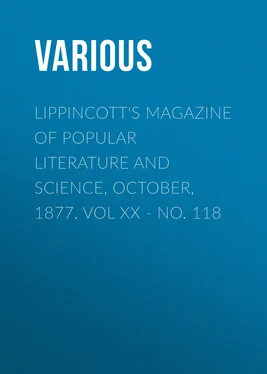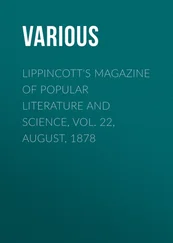Various - Lippincott's Magazine of Popular Literature and Science, October, 1877. Vol XX - No. 118
Здесь есть возможность читать онлайн «Various - Lippincott's Magazine of Popular Literature and Science, October, 1877. Vol XX - No. 118» — ознакомительный отрывок электронной книги совершенно бесплатно, а после прочтения отрывка купить полную версию. В некоторых случаях можно слушать аудио, скачать через торрент в формате fb2 и присутствует краткое содержание. Издательство: Иностранный паблик, Жанр: foreign_antique, periodic, foreign_edu, на английском языке. Описание произведения, (предисловие) а так же отзывы посетителей доступны на портале библиотеки ЛибКат.
- Название:Lippincott's Magazine of Popular Literature and Science, October, 1877. Vol XX - No. 118
- Автор:
- Издательство:Иностранный паблик
- Жанр:
- Год:неизвестен
- ISBN:нет данных
- Рейтинг книги:4 / 5. Голосов: 1
-
Избранное:Добавить в избранное
- Отзывы:
-
Ваша оценка:
- 80
- 1
- 2
- 3
- 4
- 5
Lippincott's Magazine of Popular Literature and Science, October, 1877. Vol XX - No. 118: краткое содержание, описание и аннотация
Предлагаем к чтению аннотацию, описание, краткое содержание или предисловие (зависит от того, что написал сам автор книги «Lippincott's Magazine of Popular Literature and Science, October, 1877. Vol XX - No. 118»). Если вы не нашли необходимую информацию о книге — напишите в комментариях, мы постараемся отыскать её.
Lippincott's Magazine of Popular Literature and Science, October, 1877. Vol XX - No. 118 — читать онлайн ознакомительный отрывок
Ниже представлен текст книги, разбитый по страницам. Система сохранения места последней прочитанной страницы, позволяет с удобством читать онлайн бесплатно книгу «Lippincott's Magazine of Popular Literature and Science, October, 1877. Vol XX - No. 118», без необходимости каждый раз заново искать на чём Вы остановились. Поставьте закладку, и сможете в любой момент перейти на страницу, на которой закончили чтение.
Интервал:
Закладка:
Africans of this last-named race are in some localities extremely numerous, and they do not restrict their foraging parties to succulent food. Grain is very acceptable to them, and has the advantage of keeping better than fruit, the art of drying which they have not yet mastered any more than the Bushmen or the Pi-Utes. They establish granaries in the crevices of the rocks; and these reserves of provision are sometimes of such magnitude as to make exploring expeditions on the part of the plundered Kabyles quite remunerative.
These most ancient of all the devastators which have successively descended upon Barbary are baboons of small size. They have no tails, that ancestral organ having dwindled to a wart the size of a pea. This approach to the form of man is aided by another point of personal resemblance—long whiskers. That the tail should have been worn off against the rocks, or in climbing the fences to get at orchards and melon-patches, is easily conceivable. How the evolutionists account for the retention of the beard does not yet appear. The females carry their young as adroitly and carefully as do the Kabyle women, and ascend the rocks with them with much greater activity. A young monkey has a less neglected look than a young Kabyle. His ablutions cannot be less frequent. Tourists complain that all Kabylia does not boast a single bath-house—a privation the more striking to one who has to pick his way often for miles among the ruins of Roman aqueducts, tanks and baths, the great basin in cut stone at Djema-Sahridj, which gives name to the place, being a noted example of these works.
As the vultures, dogs, negroes, Jews and jackals keep exact memoranda of the market-days, so the baboons are always on hand at harvest. Ranged in long ranks on an amphitheatre of cliffs, stroking gravely their long white beards like so many reverend episcopi or "on-lookers" confident of their tithes, they calmly contemplate the toilers in the vale below. Swift was not more certain of his "tithe-pig and mortuary guinea." Sunset comes sooner below than above. The reapers are early home, and the peaks are still purple when the marauders pour down upon the fields, and their share of the work is done with a neatness unsurpassable by reiver, ritter or kateran. The monkey-tax thus collected is quite a calculable percentage of the crop, and few taxes are more regularly paid. As it goes to non-producers, its reduction is an object constantly kept in view. The wretched guns of the natives are, however, but a feeble instrument of reform. The chassepot may succeed after having finished the rest of its task, and dispose of the baboons after the settlement of the men. The former, though not incomparably smaller than the French conscript after a protracted war, will never be made to bear arms. He is therefore useless to modern statesmen, and needs to be got rid of.
While the barn is defrauded by these little vegetarians, the barnyard is laid under tribute by a family of equally unauthorized flesh-eaters—the panthers. If this large spotted cat, known in other parts of the world as ounce, jaguar, leopard and chetah, has any choice of diet, it is for veal. But his appreciation of kid is none the less lively. Lamb, in season, comes well to him also. As there are many panthers, each of them of "unbounded stomach," and they can find little to eat in the way of wild quadrupeds, the destruction they must cause among domestic animals is seen to be serious. In the Mokuéa neighborhood each village has its panther-killer, an enterprising man set apart for a profession which sometimes becomes hereditary. One of these boasts of having killed thirty-six panthers. His father before him had bagged seventy-five, and he hoped before pulling his final trigger to have done as well. This expectation was a just one, as at twenty-eight he had already nearly halved the paternal count. The method of hunting is very simple. The sportsman fixes a bleating little victim from the herd at the foot of a tree, and climbs with his flint gun into the branches. Had the North African beast the arboreal habits of the South African tree-leopard or the American jaguar, this proceeding would be less effectual with him. But he can neither climb nor reflect like his countryman the monkey, and is picked off like a beef. One finds it difficult to get up sympathy for an animal so little able to take care of himself, or to suppose that panthers could have furnished a particularly high-spiced ingredient to the enjoyments of the Roman arena. An English bull-dog, if less picturesque, would have been far more fruitful of fighting.
Products edible neither to the wild beast nor the tooth of time are the Kabyle vases in clay. The amphoræ in common use by the women for carrying water are generally of graceful forms, comparing well in design with many of the archaic vases of Greece and the Levant. The patterns vary somewhat with the locality, but there is a resemblance which speaks of a common origin and taste. Those of the Beni-Raten all come to a blunt point at the bottom, and will not stand unsupported. The jar is made to rest upon the girdle of the bearer, while she supports it upon her back by one or both of the handles. Among the tribes nearer the Djurjura the jar has a broader and hollowed bottom, fitted to rest upon the head of the woman. It must therefore be less elongated and more rotund to admit of her reaching the handles for the purpose of balancing it. These jars weigh, filled with water, sixty pounds. In carrying one of them a Kabyle woman, it may easily be supposed, is not in a condition to study lightness of step or grace of carriage. Yet this heavy task, to which she begins to accustom herself at the age of twelve, does not appear to injure her figure or health. Such a result is more often due to violent and exceptional strains than to habitual exertion even greater in extent. The muscles are not less susceptible of education than the mind. Whatever brings out the full power of either without suddenly overtasking is healthy and beneficial.
It has been remarked that the most usual size of the Kabyle water-jar is as nearly as possible identical with the amphora kept for a standard measure in the Capitol at Rome. This coincidence may well be due rather to a correspondence in the average strength of the carriers than to a common system of authorized measures. In decoration the Kabyle vases approach the Arabic more than the Roman style. But the feeling, both in form and coloring, is decidedly more artistic than in the similar ware of Northern Europe.
Very ancient influences are manifest, too, in the work of the Kabyle silversmiths. Their diadems, ear-drops, bracelets and anklets remind one of the forms unearthed at Hissarlik and in Cyprus. In outline and chasing the rectangular, mathematical and monumental rules at the expense of the flowing and floriated. A certain pre-Phidian stiffness of handling seems to hamper the workman, as though twenty-three hundred years had been lost for him.
That there should be so much of hopeful force left in the Kabyle, artisan, agriculturist or adventurer, is creditable to him, and suggests "an original glory not yet lost." He obstinately refuses to accept the sheer professional vagabondism of the Arab, confident, as it were, that the world has in reserve better use for him than that. "Day-dawn in Africa" will probably gild his hills sooner than the tufted swamps of Guinea or the slimy huts of the Nile. A class of missionaries quite different from the Livingstones and the Moffatts have devoted themselves to his improvement. They approach him in a different way, and begin on his commercial and industrial side, not on the spiritual. The latter does not appear to be by any means so accessible. Unlike the Ashantees, the Kafirs and the M'pongwe, he was a Christian once, and may become one again. But he is not going to be evangelized on the hurrah system; and that fact his new rulers, with all their alleged defects as reformers and colonizers, have sense enough to recognize. The new faith must push its way in the rear of works. Peace, good government, good roads, better implements and methods of labor will promote the enlightenment necessary to its success.
Читать дальшеИнтервал:
Закладка:
Похожие книги на «Lippincott's Magazine of Popular Literature and Science, October, 1877. Vol XX - No. 118»
Представляем Вашему вниманию похожие книги на «Lippincott's Magazine of Popular Literature and Science, October, 1877. Vol XX - No. 118» списком для выбора. Мы отобрали схожую по названию и смыслу литературу в надежде предоставить читателям больше вариантов отыскать новые, интересные, ещё непрочитанные произведения.
Обсуждение, отзывы о книге «Lippincott's Magazine of Popular Literature and Science, October, 1877. Vol XX - No. 118» и просто собственные мнения читателей. Оставьте ваши комментарии, напишите, что Вы думаете о произведении, его смысле или главных героях. Укажите что конкретно понравилось, а что нет, и почему Вы так считаете.












